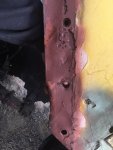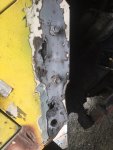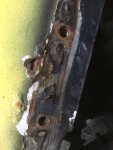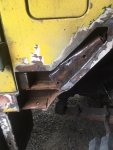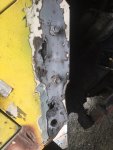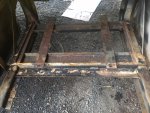ldmack3
Well-known member
- 849
- 1,740
- 93
- Location
- N. Central Idaho
Need some ideas on rust repair for my M35A2.
The fenders attach to the cab structure with 3 - 1/2” bolts. On both sides this is a major rust factory.
RH side has no access to the nut side on two as they inside the channel structure. Top point is open access and is good, middle is very loose with no access and I fear will break off when I reattach the fender, lower is totally gone with no access. I can spray rust remover/preventive through the 3 holes knowing it won't get every nook and cranny, just hoping for the best. I do not have a facility where I can remove the cab and do the repair correctly. For the fastener repair I'm thinking of drilling a 2 holes in the back of the channel by going through the attach point. Probably taking a 3” bolt to fasten the fender back on. Another option is to cut out the rusted side of the channel and weld in a new plate, maybe 3/16” after welding on nut plates, or threading the plate (not my fav) or drill through like mentioned above. With a section cut out I would also have a better treatment of the rust. Not sure my little MIG can weld 3/16.
LH fender is similar except there is access to 2 of the three attach points. Again major rust area. Top hole is outside the channel as the RH is. Middle hole has access though the back of the channel I can stick a washer and nut on a bolt. See pic with my finger sticking out. Bottom hole is totally gone and no access so eithr drilling or plate replacement.
Both sides have additional rust in that area up towards the vent. I can cut out some sheet metal and weld in a new piece, but knowing myself if I cut it out and find more problems I won't be able to let it go. Work scope creep doesn't begin to describe what is happening?
Long winded but wanted to give enough description for some good responses.
The fenders attach to the cab structure with 3 - 1/2” bolts. On both sides this is a major rust factory.
RH side has no access to the nut side on two as they inside the channel structure. Top point is open access and is good, middle is very loose with no access and I fear will break off when I reattach the fender, lower is totally gone with no access. I can spray rust remover/preventive through the 3 holes knowing it won't get every nook and cranny, just hoping for the best. I do not have a facility where I can remove the cab and do the repair correctly. For the fastener repair I'm thinking of drilling a 2 holes in the back of the channel by going through the attach point. Probably taking a 3” bolt to fasten the fender back on. Another option is to cut out the rusted side of the channel and weld in a new plate, maybe 3/16” after welding on nut plates, or threading the plate (not my fav) or drill through like mentioned above. With a section cut out I would also have a better treatment of the rust. Not sure my little MIG can weld 3/16.
LH fender is similar except there is access to 2 of the three attach points. Again major rust area. Top hole is outside the channel as the RH is. Middle hole has access though the back of the channel I can stick a washer and nut on a bolt. See pic with my finger sticking out. Bottom hole is totally gone and no access so eithr drilling or plate replacement.
Both sides have additional rust in that area up towards the vent. I can cut out some sheet metal and weld in a new piece, but knowing myself if I cut it out and find more problems I won't be able to let it go. Work scope creep doesn't begin to describe what is happening?
Long winded but wanted to give enough description for some good responses.
Attachments
-
55.7 KB Views: 46
-
59.6 KB Views: 44
Last edited:


